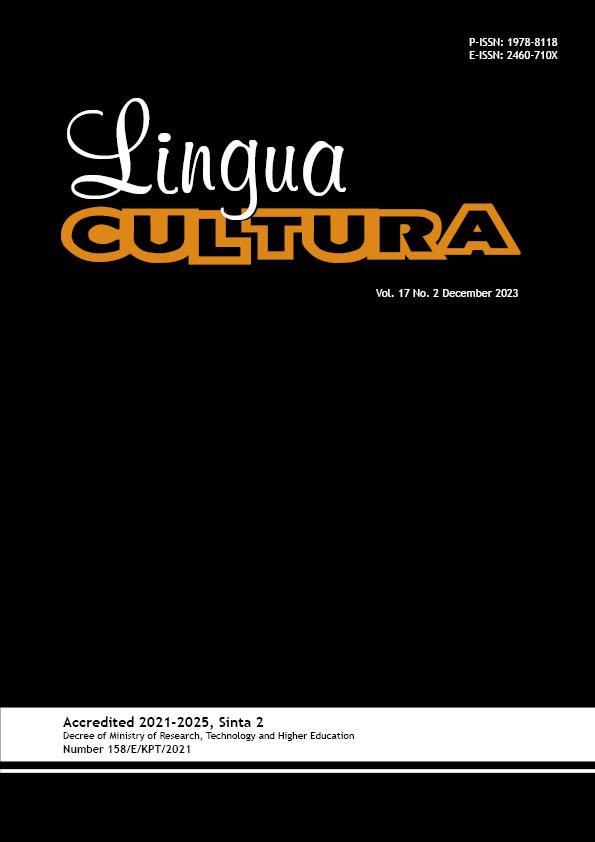Forensic Linguistic Analysis: Civil Servant Speech Equating Prostitutes with Probolinggo Parliament Members
DOI:
https://doi.org/10.21512/lc.v17i2.10645Keywords:
forensic linguistics, defamation, legal investigationAbstract
The research investigated an alleged defamation statement made by a civil servant in Probolinggo, suggesting that the Regional People's Representative Council of Probolinggo (DPRD Probolinggo) held a lower social status than local sex workers, employing forensic linguistics as its analytical framework. The research was a single case study that applied a qualitative approach to analyze the data. A single case study was a suitable method for analyzing a single case of an individual; here was a civil servant in a socialization event attended by the regional government. The data consisted of four sentences of verbal statements and eight accompanying non-verbal cues made by the civil servant toward Probolinggo Parliament members. The research uncovers that the civil servant's remarks contain pointed appraisals and judgments aimed at DPRD Probolinggo members, ultimately leading to legal action predicated on allegations of defaming the collective dignity of DPRD Probolinggo. However, it is important to emphasize that these critical assessments are specific to certain members rather than constituting a comprehensive censure of the entire institutional body. Consequently, the civil servant may potentially be exempt from institutional defamation charges, with these actions interpreted as robust workplace criticisms. Nevertheless, the research underscores the potential legal repercussions stemming from such critiques and the need for a meticulous evaluation of their legal implications within the legal framework, given their potential to generate future legal disputes.
References
Abdulghafor, R., Abdelmohsen, A., Turaev, S., Ali, M. A. H., & Wani, S. (2022). An analysis of body language of patients using artificial intelligence. Healthcare, 10(12), 2504. https://doi.org/10.3390/healthcare10122504.
Ahn, D. (2022). Indirectly direct: An account of demonstratives and pointing. Linguistics and Philosophy, 45(6), 1345-1393. https://doi.org/10.1007/s10988-022-09350-5.
Bachari, A. D. (2019). Analysis of form and theme of hate speech against president Joko Widodo on social media: A forensic linguistic study. In Proceedings of the Second Conference on Language, Literature, Education, and Culture (ICOLLITE 2018). Bandung, Indonesia. https://doi.org/10.2991/icollite-18.2019.49.
Biela, B. (2022). Opposition’s allegation against corruption eradication commission (KPK) in Indonesia: Is it cyberbullying according to forensic linguistics? In Proceedings of the 1st International Conference on Language, Literature, Education and Culture, ICOLLEC 2021, 9-10 October 2021, Malang, Indonesia. Malang, Indonesia, Malang, Indonesia. https://doi.org/10.4108/eai.9-10-2021.2319472.
Chico, K. Z. H. (2022). An analysis of factors influencing EFL learners’ writing skills. Canadian Journal of Language and Literature Studies, 2(2), 28-38. https://doi.org/10.53103/cjlls.v2i2.38.
Cienki, A. (2022). The study of gesture in cognitive linguistics: How it could inform and inspire other research in cognitive science. WIREs Cognitive Science, 13(6), e1623. https://doi.org/10.1002/wcs.1623.
Coulthard, M. (2010). Forensic linguistics: The application of language description in legal contexts. Langage et Société, 132(2), 15-33. https://doi.org/10.3917/ls.132.0015.
Ilmiah, W. S., Azizah, F. M., & Amelia, N. S. (2018). Pendidikan kesehatan tentang seks aman dan teknik negosiasi serta pemberian kondom oleh wanita pekerja seks di desa Besuk Probolinggo. Jurnal Pengabdian Kepada Masyarakat, 2(1), 17-23.
Ishak, S., Malik, F., & Suwarti, S. (2023). Analysis of imprisonment implementation against the perpetrators of the cybercrimes. Journal of Social Science, 4(2), 320-338. https://doi.org/10.46799/jss.v4i2.538.
Martin, J. R., & White, P. R. R. (2005). The language of evaluation. UK: Palgrave Macmillan. https://doi.org/10.1057/9780230511910.
Neoh, M. J. Y., Teng, J. H., Lee, A., Setoh, P., Mulatti, C., & Esposito, G. (2022). Negative emotional reactions to criticism: Perceived criticism and source affects extent of hurt and relational distancing. PLOS ONE, 17(8), e0271869. https://doi.org/10.1371/journal.pone.0271869.0
Nilufar, N. (2023). Features of appointing a froensic-linguistic expertise on defamation of a person content material. American Journal of Philological Sciences, 3(5), 16-23. https://doi.org/10.37547/ajps/Volume03Issue05-04.
Pikiran Rakyat. (2023, May 27). Viral ASN di Probolinggo “ngamuk†ke DPRD sebut lebih mulia PSK. Retrieved from https://www.pikiran-rakyat.com/video/detail/32768/viral-asn-di-probolinggo-ngamuk-ke-dprd-sebut-lebih-mulia-psk.
Rofiq, M. (2023). DPRD Probolinggo laporkan ASN yang menyamakan anggota dewan dengan pelacur. Retrieved from https://www.detik.com/jatim/hukum-dan-kriminal/d-6735295/dprd-probolinggo-laporkan-asn-yang-menyamakan-anggota-dewan-dengan-pelacur.
Silpani, D. C., Suematsu, K., Yoshida, K. (2022). A feasibility study on hand gesture intention interpretation based on gesture detection and speech recognition. Journal of Advanced Computational Intelligence and Intelligent Informatics, 26(3), 375-381. https://doi.org/10.20965/jaciii.2022.p0375.
Tayebi, T., & Coulthard, M. (2022). New trends in forensic linguistics. Language and Law: Linguagem e Direito, 9(1), 1-8. https://doi.org/10.21747/21833745/lanlaw/9_1ed.
Vidhiasi, D. M., Saifullah, A. R., & Bachari, A. D. (2023). The evaluation of alleged defamation: A forensic linguistics analysis. Al-Lisan: Jurnal Bahasa, 8(2), 139-153. https://doi.org/10.30603/al.v8i2.3482.
Zada, S., Khan, J., Saeed, I., Wu, H., Zhang, Y., & Mohamed, A. (2022). Shame: Does it fit in the workplace? Examining supervisor negative feedback effect on task performance. Psychology Research and Behavior Management, 15, 2461-2475. https://doi.org/10.2147/PRBM.S370043.
Downloads
Published
How to Cite
Issue
Section
License
Copyright (c) 2023 Fadhli Adbaka, Dr. Frans Asisi Datang, S.S., M.Hum

This work is licensed under a Creative Commons Attribution-ShareAlike 4.0 International License.
Authors who publish with this journal agree to the following terms:
a. Authors retain copyright and grant the journal right of first publication with the work simultaneously licensed under a Creative Commons Attribution License - Share Alike that allows others to share the work with an acknowledgment of the work's authorship and initial publication in this journal.
b. Authors are able to enter into separate, additional contractual arrangements for the non-exclusive distribution of the journal's published version of the work (e.g., post it to an institutional repository or publish it in a book), with an acknowledgment of its initial publication in this journal.
c. Authors are permitted and encouraged to post their work online (e.g., in institutional repositories or on their website) prior to and during the submission process, as it can lead to productive exchanges, as well as earlier and greater citation of published work.
USER RIGHTS
All articles published Open Access will be immediately and permanently free for everyone to read and download. We are continuously working with our author communities to select the best choice of license options, currently being defined for this journal as follows: Creative Commons Attribution-Share Alike (CC BY-SA)


















